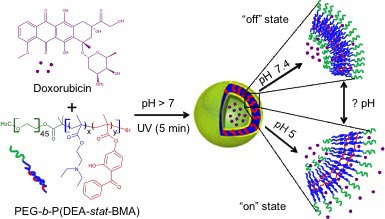Brigitte Voit Group
Synthesis and characterization of functionalized polymers; glycodendrimers and bioconjugates for therapeutics, cellular mimics

The group of Prof. Voit has been engaged in the field of dendritic polymers since about 20 years with main focus on the imperfectly hyperbranched structures, but also more recently in some perfectly branched dendrimers. Here, the synthesis of these materials covering a variety of condensation and addition type reactions has been strongly explored, followed by an intensive characterization, elucidating the highly branched structures and their different units, looking into structure development and kinetics and making great efforts to develop more reliable molar mass determination methods.
Dendritic polymers are widely used as multifunctional materials with specific properties (dendritic effect of surface groups and globular shape) for potential (bio-)medical and pharmaceutical applications such as e.g. DNA and drug carrier systems. The fundamental interest to understand the role of carbohydrates/oligosaccharides in various biological processes is steadily growing up besides the prerequisite to improve the behavior and the biological properties of dendritic polymers towards biological molecules and systems. In this context, one research interest of us is to focus on the fundamental understanding of the interaction, complexation and encapsulation properties of dendritic polymers with various oligosaccharide architectures to contribute to the development of potential diagnostic and therapeutic agents.
Besides, the field of dendritic polymers, the synthesis of functional polymers and different polymer architectures by free and controlled radical polymerization (RAFT, NMRP, ATRP) as well as cationic polymerization is covered by a variety of activities in the Voit group. Providing biocompatible and bioactive polymer surfaces for studies in biomedical application is one of the major issues of the current research activities. Here, especially the control of cell attachment or cell release on surfaces as well as control of the cell growth and cell differential by the surface chemistry and physical nature is addressed. Similarly, surfaces for biosensors and mimicking biological surfaces with their specific interactions are addressed.
Of special recent interest is the field of different carrier systems based on glycodendrimers, polymersomes or nanocapsules. In Scheme 1, the self-assembly of specific amphiphilic block copolymers to pH sensitive and UV-crosslinkable polymersomes is outlined and the pH sensitive release of doxorubicin.
In addition, polymeric functional and patternable (by UV light or thermal treatment) surfaces were provided for site-specific attachment of nanoobjects, and block copolymers with orthogonally protected segments were synthesized providing highly ordered and stimuli selective nanostructures in thin films. The main objective of these studies is to provide a selective multifunctionality in polymer structures with potential use in microsystems.

Future Projects and Goals
Projects within the DIPP will further focus on the integration of specific synthetic binding groups or biomolecules into hydrogels and hydrogel layers on surfaces. Concepts of molecular imprinting and bioconjugation are explored. The concept of various biocompatible and bioactive polymeric globular systems as carrier systems for different biomedical applications (diagnostics, therapy, gene transfection, bioactive coatings) as well as aspects of synthetic biology will be expanded.
In addition, the first successful studies in the field of nanotechnology will be expanded to transfer concepts of selfassembly in polymer science to the use of nano-patterning for e.g. biosensor preparation and in nano-electronics.
Methodological and Technical Expertise
- In general: expertise in synthetic organic chemistry and polymer chemistry
- Synthesis of functional polymer architectures and hydrogels
- Characterization of functional polymer architectures in solution with regard to chemical structure, size, molar mass and interactions e.g. by dynamic light scattering, size-exclusion chromatography, Flow field flow fractionation (4F), Maldi-TOF, NMR, IR, zeta potential measurements, TEM, AFM, and others
- Characterization of hydrogels and thin functional polymer films with regard to surface properties and interactions by various methods